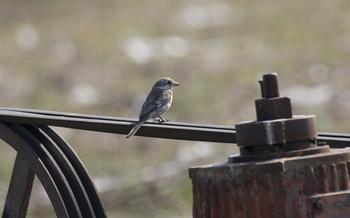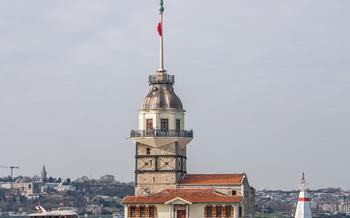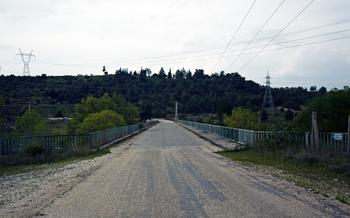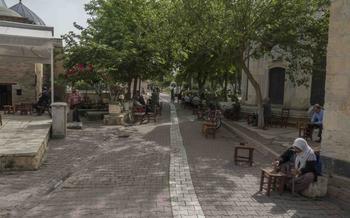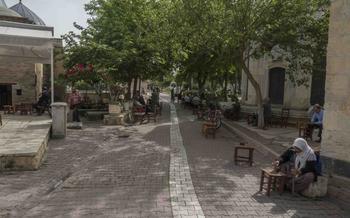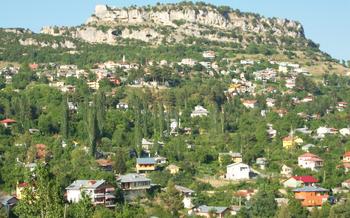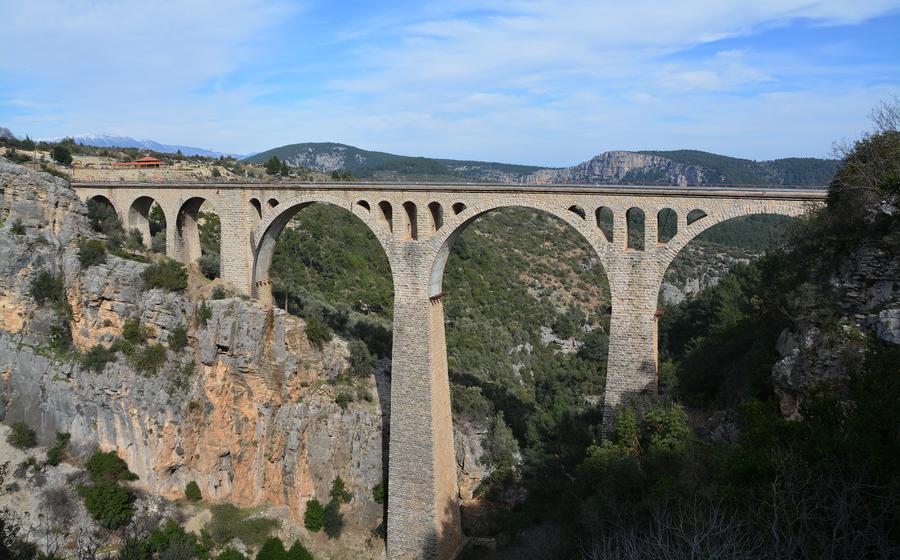
Varda Viaduct (German Bridge)
- History of the Varda Viaduct
- Location and Accessibility
- Engineering Marvel
- Panoramic Views
- Walking and Hiking Trails
- Birdwatching Opportunities
- Cultural Significance
- Photography Opportunities
- Guided Tours
- Local Cuisine
- Accommodation Options
- Souvenirs and Handicrafts
- Safety Tips
- Insider Tip
History of the Varda Viaduct
The Varda Viaduct, also known as the German Bridge, stands as a testament to the ingenuity of German engineers and the significance of infrastructure during World War I. Constructed between 1905 and 1907, the viaduct served as a vital link for transporting troops and supplies between Anatolia and the Middle East. Its strategic location allowed the Ottoman Empire to maintain control over the region during a time of turmoil and conflict.
The viaduct's design reflects the architectural style of the early 20th century, showcasing a blend of functionality and aesthetics. Its 17 arches, each spanning 40 meters in length, create a striking visual that blends seamlessly with the rugged Taurus Mountains and the flowing Ceyhan River. Anecdotes and stories surrounding its construction highlight the challenges faced by the German engineers, who worked tirelessly to complete the project amidst political tensions and the harsh conditions of the Anatolian terrain.
Location and Accessibility
The Varda Viaduct, also known as the German Bridge, is situated in the Yüreğir district of Adana, Turkey. This impressive structure spans the Ceyhan River, connecting the city of Adana to the town of Ceyhan. Reaching the viaduct is relatively easy, thanks to its strategic location.
To get there by car, follow the D-400 highway, which runs through Adana. Take the Ceyhan exit and continue on the road towards the town of Ceyhan. You will find the viaduct approximately 10 kilometers from the exit, towering over the Ceyhan River.
Public transportation is also a convenient option. Take a bus or minibus from Adana's city center to Ceyhan. Once in Ceyhan, ask for directions to the viaduct, as it is a well-known landmark in the area.
When visiting the Varda Viaduct, make sure to find the best viewpoint to capture stunning photographs. The bridge offers panoramic views of the surrounding landscape, including the Taurus Mountains and the Ceyhan River. For the most breathtaking shots, consider visiting during sunrise or sunset, when the golden hues of the sky create a magical backdrop.
Engineering Marvel
The Varda Viaduct stands as a testament to the ingenuity and skill of the German engineers who designed and built it. Constructed using innovative techniques and materials for its time, the viaduct's structural integrity is a marvel of engineering. The use of reinforced concrete, a relatively new material at the time, allowed for the creation of a lightweight yet strong structure. The viaduct's design features multiple arches, each carefully calculated to distribute the weight of the bridge and the trains that pass over it.
The construction of the viaduct was not without its challenges. The engineers had to contend with the rugged terrain and the harsh climate of the region. They also faced the logistical challenge of transporting materials and equipment to the remote construction site. Despite these difficulties, the viaduct was completed in just over two years, a remarkable feat considering the complexity of the project.
The Varda Viaduct serves as a reminder of the remarkable achievements that can be accomplished through human ingenuity and engineering prowess. Its enduring strength and functionality have made it an iconic landmark in Turkey, a symbol of the country's rich history and engineering expertise.
Panoramic Views
The Varda Viaduct unveils breathtaking panoramas that will leave you spellbound. As you stand atop this magnificent structure, your gaze will be captivated by the majestic Taurus Mountains, their rugged peaks piercing the azure sky. The mighty Ceyhan River, a lifeline for the region, meanders gracefully beneath the bridge, its shimmering waters reflecting the golden sunlight. The surrounding landscape is a tapestry of vibrant colors, with lush greenery, fertile fields, and picturesque villages dotting the horizon.
The viaduct offers multiple vantage points, each revealing a unique perspective. For the most awe-inspiring views, visit during the golden hours of sunrise or sunset. As the sun dips below the horizon, the sky transforms into a canvas of fiery hues, casting a warm glow on the surrounding landscape. The viaduct itself becomes a silhouette against the vibrant backdrop, creating a picture-perfect moment that will remain etched in your memory.
Whether you're a seasoned photographer seeking the perfect shot or a nature enthusiast seeking tranquility, the Varda Viaduct promises an unforgettable experience. Let the panoramic vistas wash away your worries and immerse yourself in the beauty that unfolds before you.
Walking and Hiking Trails
In addition to its historical significance and engineering marvels, the Varda Viaduct is surrounded by breathtaking natural beauty that can be explored on foot. Several walking and hiking trails wind their way through the area, offering visitors a chance to immerse themselves in the stunning scenery.
One popular route is the Varda Viaduct Trail, which takes hikers along the base of the bridge and offers panoramic views of the Taurus Mountains. The trail is well-maintained and suitable for hikers of all skill levels. Along the way, hikers can admire the intricate stonework of the viaduct and learn about its construction from informative signage.
For those seeking a more challenging hike, the Taurus Mountains offer a variety of trails that range from moderate to strenuous. These trails lead through dense forests, past cascading waterfalls, and up to mountain peaks with breathtaking views. Hikers should come prepared with proper footwear, water, and snacks, as well as a map or GPS device to navigate the trails.
Before embarking on a hike, it's important to check the weather forecast and dress appropriately. The weather in the Taurus Mountains can change quickly, so it's always a good idea to bring layers of clothing and a raincoat. It's also important to be aware of the local wildlife, including wild boars and bears, and to take necessary precautions to avoid encounters.
Whether you're a seasoned hiker or simply looking for a leisurely stroll, the Varda Viaduct and its surroundings offer a variety of trails to suit all preferences. So lace up your hiking boots, grab your camera, and get ready to explore the natural wonders of this region.
Birdwatching Opportunities
The Varda Viaduct, nestled amidst the natural wonders of Adana, serves as a haven for birdwatchers and bird enthusiasts. The diverse topography of the area, encompassing wetlands, forests, and cliffs, provides a suitable habitat for a wide range of bird species. From majestic eagles soaring above the viaduct to colorful songbirds flitting through the trees, the viaduct offers a rich and vibrant birdwatching experience.
With keen eyes and a pair of binoculars, visitors can spot a variety of bird species, including the majestic Imperial Eagle, the elegant Red-footed Falcon, and the vibrant Blue-cheeked Bee-eater. The viaduct's unique location, acting as a natural corridor for migratory birds, attracts a diverse range of species during the spring and autumn migration seasons. Birdwatchers can witness the spectacle of thousands of birds taking flight, creating a breathtaking spectacle against the backdrop of the viaduct's grand architecture.
For those new to birdwatching, the viaduct's surroundings provide an excellent opportunity to learn about the fascinating world of birds. Visitors can bring a field guide or download a bird identification app to help them identify the different species they encounter. Local birdwatching groups and guided tours are also available for those who want to enhance their birding experience and learn from experts.
Whether you are an experienced birdwatcher or just starting out, the Varda Viaduct offers an unforgettable birdwatching experience. With its diverse birdlife, stunning scenery, and easy accessibility, the viaduct is a paradise for nature enthusiasts and bird lovers alike.
Cultural Significance
The Varda Viaduct stands as a testament to the interconnectedness of cultures and the enduring legacy of historical events. Constructed during a time of global conflict, the bridge served as a vital link between different regions, fostering cultural exchanges and facilitating the movement of people and goods.
Over the years, the viaduct has witnessed countless stories of human interaction and cultural convergence. Locals and visitors alike have crossed its path, leaving behind a tapestry of shared experiences and memories. The bridge has become a symbol of unity, resilience, and the enduring spirit of cooperation among diverse communities.
One particularly poignant tale is that of a young engineer from Istanbul who traveled to Adana to work on the construction of the viaduct. During his time there, he fell in love with a local woman, and they eventually married and settled down in the city. Their descendants still reside in Adana, carrying on the legacy of their ancestors who helped build this remarkable structure.
The Varda Viaduct has also played a role in shaping local traditions and customs. The annual "Bridge Festival," held near the viaduct, celebrates the cultural heritage of the region and brings together people from all walks of life. During the festival, visitors can enjoy traditional music, dance, and cuisine, as well as participate in various cultural workshops and activities.
Through its enduring presence, the Varda Viaduct has become an integral part of the cultural fabric of Adana. It serves as a reminder of the city's rich history, diverse population, and the spirit of unity that binds its people together.
Photography Opportunities
The Varda Viaduct is a photographer's paradise, attracting enthusiasts and Instagrammers from around the world. With its stunning architecture, panoramic views, and natural surroundings, the bridge offers endless opportunities for capturing breathtaking shots.
For the best photography experience, consider arriving early in the morning or late in the afternoon when the light is soft and golden. Experiment with different angles and perspectives to create unique compositions. The viaduct looks particularly impressive when photographed from below, showcasing its towering structure against the sky.
Don't forget to capture the surrounding landscape as well. The Taurus Mountains, the Ceyhan River, and the lush vegetation provide a beautiful backdrop for your shots. If you have a drone, take advantage of the aerial perspective to capture stunning panoramic images of the viaduct and its surroundings.
Remember to be respectful of other visitors and avoid disrupting their experience while taking photos. Follow any regulations or restrictions regarding photography at the viaduct, and be mindful of your surroundings to ensure safety.
Guided Tours
For those seeking a deeper understanding of the Varda Viaduct's history and significance, guided tours are readily available. These tours, led by knowledgeable local experts, offer a range of options catering to diverse interests, from historical and engineering-focused tours to nature-oriented explorations.
By opting for a guided tour, visitors gain invaluable insights into the viaduct's construction, its role in World War I, and its enduring cultural significance. Guides share captivating stories and anecdotes, bringing the viaduct's past to life and offering a unique perspective on its enduring legacy.
To ensure a rewarding experience, it is advisable to research and select a reputable tour operator. Advance booking is recommended, especially during peak tourist season, to avoid disappointment and secure a spot on the desired tour. Whether you're a history buff, an engineering enthusiast, or simply seeking a deeper connection with the region's heritage, a guided tour of the Varda Viaduct promises an enriching and memorable experience.
Local Cuisine
Adana is renowned for its delectable cuisine, and no visit to the Varda Viaduct would be complete without sampling some of the local flavors. The city is particularly famous for its Adana kebab, a succulent skewer of minced lamb grilled to perfection. This mouthwatering dish is often served with bulgur pilaf, grilled tomatoes, and peppers.
Another must-try is the şırdan, a specialty made from lamb's stomach stuffed with rice, herbs, and spices. For a taste of local bread, order some freshly baked tandır ekmeği, a traditional flatbread cooked in a clay oven.
To satisfy your sweet tooth, indulge in künefe, a delightful dessert made from shredded filo dough, cheese, and syrup. For a refreshing drink, try şalgam suyu, a fermented turnip juice that is a local favorite.
When looking for a place to dine, consider visiting one of the many local restaurants or eateries near the viaduct. These establishments often offer authentic Adana cuisine at reasonable prices. Be sure to ask for recommendations from locals to discover hidden gems and avoid tourist traps.
My personal experience of savoring the local cuisine was truly unforgettable. I had the pleasure of dining at a traditional restaurant near the viaduct, where I was treated to a feast of Adana kebab, şırdan, and künefe. The flavors were exquisite, and the hospitality of the staff was exceptional. The memory of that meal still lingers in my mind, reminding me of the culinary wonders that Adana has to offer.
Accommodation Options
The Varda Viaduct, nestled in the picturesque landscapes of Adana, offers visitors a range of accommodation options to suit diverse preferences and budgets. From cozy guesthouses to modern hotels, there's something for every traveler.
If you seek a budget-friendly option, consider the charming guesthouses in the vicinity of the viaduct. These establishments often provide a warm and welcoming atmosphere, allowing you to immerse yourself in the local culture. For a more luxurious experience, opt for one of the elegant hotels that offer stunning views of the viaduct and the surrounding countryside.
To ensure a comfortable stay, it's advisable to book your accommodation in advance, especially during the peak tourist season. Online booking platforms and travel agencies can assist you in finding the best deals and comparing amenities.
Here's a personal recommendation: I had the pleasure of staying at a quaint guesthouse just a short walk from the viaduct. The hosts were incredibly hospitable and provided valuable insights into the region's history and culture. The traditional Turkish breakfast served each morning was an absolute delight.
Souvenirs and Handicrafts
Souvenirs and Handicrafts:
The Varda Viaduct is not only a historical and engineering marvel but also a great place to shop for unique souvenirs and handicrafts. Visitors can find a variety of local shops and markets near the viaduct, selling everything from traditional Turkish textiles and ceramics to handmade jewelry and carpets.
One of the most popular souvenirs to buy is a miniature replica of the Varda Viaduct, which can be found in many of the shops near the bridge. These replicas are usually made of metal or wood and are a great way to remember your visit to this iconic landmark.
Another popular souvenir is a traditional Turkish rug. These rugs are hand-woven using intricate designs and patterns, and they make a beautiful addition to any home. Visitors can find a wide variety of rugs to choose from, in different sizes, colors, and designs.
If you are looking for something more unique, you can also find a variety of handmade jewelry and pottery in the shops near the Varda Viaduct. These items are often made by local artisans using traditional techniques, and they make great gifts for friends and family back home.
When shopping for souvenirs in Turkey, it is important to remember to bargain. The prices quoted in the shops are often just a starting point, and you can usually get a good deal if you are willing to haggle.
Here are some tips for bargaining in Turkey:
- Be polite and respectful.
- Start by offering a price that is about half of what the seller is asking.
- Be prepared to walk away if the seller is not willing to come down in price.
- If you are buying multiple items, you can often get a better price if you buy them all from the same seller.
With a little patience and bargaining, you can find some great souvenirs and handicrafts to remember your visit to the Varda Viaduct and Turkey.
Safety Tips
When visiting the Varda Viaduct, safety should always be a top priority. Here are some important tips to keep in mind:
-
Respect Local Customs and Traditions: Adana is a culturally rich city, and it's essential to show respect for local customs and traditions. Dress modestly, especially when visiting religious sites, and be mindful of your behavior in public.
-
Stay Hydrated and Protected: The weather in Adana can be hot and dry, so it's crucial to stay hydrated by drinking plenty of water throughout the day. Sunscreen, sunglasses, and a hat are also essential for protection from the sun.
-
Be Aware of Your Surroundings: As with any travel destination, it's important to be aware of your surroundings and take necessary precautions to avoid theft or other safety concerns.
-
Personal Anecdote: During my visit to the Varda Viaduct, I made sure to follow these safety tips and had a safe and enjoyable experience. I dressed respectfully, stayed hydrated, and was mindful of my surroundings. I also interacted with some locals, who were incredibly friendly and welcoming.
Insider Tip
While exploring the vicinity of the Varda Viaduct, be sure to venture a bit further to discover the hidden gem of Karacaören Village. Nestled amidst picturesque landscapes, this charming village offers a glimpse into the authentic Turkish countryside. Take a leisurely stroll through its cobblestone streets, lined with traditional houses adorned with vibrant flowers. Engage with the friendly locals, who warmly welcome visitors and are eager to share stories about their culture and traditions. Don't miss the opportunity to savor a delicious home-cooked meal at one of the local restaurants, where you can indulge in mouthwatering regional specialties prepared with fresh, local ingredients. Karacaören Village provides a unique opportunity to experience the true essence of Turkish hospitality and immerse yourself in the charm of rural life.
